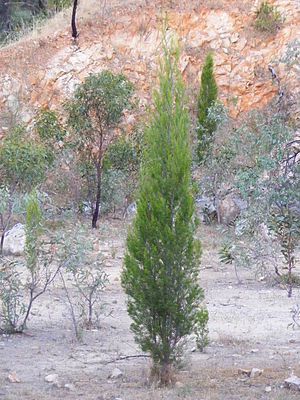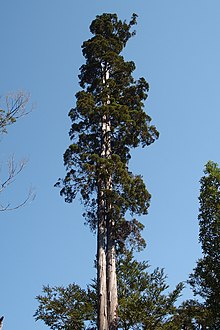Callitroideae
| Callitroideae | ||||||||||||
|---|---|---|---|---|---|---|---|---|---|---|---|---|

|
||||||||||||
| Systematics | ||||||||||||
|
||||||||||||
| Scientific name | ||||||||||||
| Callitroideae | ||||||||||||
| Saxton |
Callitroideae is a subfamily of the family of the cypress family (Cupressaceae). The ten genera are only common in the southern hemisphere.
description
The species from the subfamily Callitroideae grow as evergreen shrubs or trees . The younger leaves are usually needle-shaped, while the older leaves are scale-like and usually close to the branches. They are opposite (e.g. Austrocedrus ) , in three whorls (e.g. Actinostrobus ) or in four whorls (e.g. Neocallitropsis ).
The species of the Callitroideae are single sexed ( monoecious ) or dioecious separately sexed ( dioecious ). The cones usually consist of two cone scale whorls, sometimes the whorl below is included in the cone. With all cones seeds are formed in the axils of the upper cone scales, with many genera also in the axils of the one below. The species of the Libocedrus group ( Austrocedrus , Libocedrus , Papuacedrus , Pilgerodendron ) only develop four seeds per cone, while Callitris species can be considerably more, which are in several rows. In some genera, a columella is formed in the center of the cone (e.g. Actinostrobus , Callitris , Diselma ), which is the elongated axis of the cone .

Systematics and distribution
The subfamily Callitroideae was established in 1913 by WT Saxton in New Phytologist , Volume 12, page 255. The type genus is Callitris Vent.
The ten genera are only common in the southern hemisphere.
There are ten recent genera in the subfamily Callitroideae, six of which are monotypical , i.e. contain only one species.
- Scaled cypress ( Actinostrobus Miq. ): The three species occur only in a small coastal area in the southwestern Australian state of Western Australia . Some authors also place them on Callitris .
-
Austrocedrus Florin & Boutelje : There is only one species:
- Chile cedar ( Austrocedrus chilensis (D.Don) Pic.Serm. & Bizzarri ): It thrives in mountainous regions in southern Argentina and Chile.
- Ornamental cypress ( Callitris Vent. ): There are about 15 species in Australia including Tasmania and New Caledonia .
-
Diselma Hook. f. : There is only one type:
- Tasmanian cypress ( Diselma archeri Hook. F. ): This endemic only thrives in alpine altitudes in western Tasmania.
-
Fitzroya Hook. f. ex Lindl. : There is only one type:
- Patagonian cypress ( Fitzroya cupressoides (Molina) IMJohnst. ): It thrives in the rainforest in southern Chile and neighboring areas in Argentina.
- Scaled Cedars ( Libocedrus Endl. ): Of the approximately five species, three are found in New Caledonia and two in New Zealand .
-
Neocallitropsis Florin : There is only one species:
- Neocallitropsis pancheri (Carrière) de foliage. : The rare and endangered species only occurs in New Caledonia. Some authors put it as Callitris pancheri (Carrière) Byng to Callitris .
-
Papuacedrus H.L.Li : There is only one species:
- Papuacedrus papuana (F.Muell.) HLLi : It occurs from the Moluccas to New Guinea .
-
Pilgerodendron Florin : There is only one type:
- Pilgerodendron uviferum Florin : It thrives in rainy mountain regions in southern Argentina and Chile.
- African cypress ( Widdringtonia Endl. ): Depending on the view, there are four to seven species in southern Africa.
swell
- Paul A. Gadek, Deryn L. Alpers, Margaret M. Heslewood, Christopher J. Quinn: Relationships within Cupressaceae sensu lato: A combined morphological and molecular approach . In: American Journal of Botany . Volume 87, No. 7 , 2000, pp. 1044-1057 (English, amjbot.org [PDF]).
Individual evidence
- ^ A b c d e Paul A. Gadek, Deryn L. Alpers, Margaret M. Heslewood, Christopher J. Quinn: Relationships within Cupressaceae sensu lato: A combined morphological and molecular approach . In: American Journal of Botany . Volume 87, No. 7 , 2000, pp. 1044-1057 (English, amjbot.org [PDF]).
- ↑ a b c d e f g h i j k l m n Armin Jagel, Veit Dörken: Morphology and morphogenesis of the seed cones of the Cupressaceae - part III. Callitroideae. In: Bulletin of the Cupressus Conservation Project , number 10, volume 4, number 3, December 19, 2015, pp. 91-103 ( PDF )
- ↑ a b c d Rafaël Govaerts (ed.): Cupressaceae. In: World Checklist of Selected Plant Families (WCSP) - The Board of Trustees of the Royal Botanic Gardens, Kew . Retrieved March 20, 2019.

